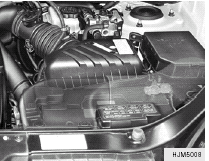If the engine will not start
WARNING:
If the engine will not start, do not push or
pull the car to start it. This could result in a
collision or cause other damage. In addition,
push or pull starting may cause the
catalytic converter to be overloaded and
create a fire hazard.

If Engine Doesn't Turn Over or Turns Over Slowly
1. If your car has an automatic transaxle, be sure the gear selector lever is in "N" or "P" and the emergency brake is set.
2. Check the battery connections to be sure they are clean and tight.
3. Turn on the interior light. If the light dims or goes out when you operate the starter, the battery is discharged.
4. Check the starter connections to be sure they are securely tightened.
5. Do not push or pull the vehicle to start it. See instructions for "Jump Starting".
If Engine Turns Over Normally but Does Not Start
1. Check fuel level.
2. With the key in the "OFF" position, check all connectors at ignition, coil and spark plugs.
Reconnect any that may be disconnected or loose.
3. Check the fuel line in the engine compartment.
4. If the engine still does not start, call a Hyundai dealer or seek other qualified assistance.
If Engine Stalls While Driving
1. Reduce your speed gradually, keeping a straight line. Move cautiously off the road to a safe place.
2. Turn on your emergency flashers.
3. Try to start the engine again. If your vehicle will not start, contact a Hyundai dealer or seek other qualified assistance.
If the engine stalls at a crossroad or crossing
If the engine stalls at a crossroad or crossing, set the shift lever in the N(Neutral) position and then push the vehicle to a safe place.
See also:
Checking the Battery
WARNING:
Batteries can be dangerous! When working with batteries, carefully observe the
following precautions to avoid serious injuries.
The fluid in the battery contains a strong solution of su ...
SRS Care
The SRS is virtually maintenance-free and there are no parts you can safely service
by yourself. If the SRS "AIR BAG" warning light does not illuminate, or continuously
remains on, have ...
RADIO, SET UP, VOLUME CONTROL (PA710S) (If Installed)
1. AM Selection Button
2. FM Selection Button
3. XM Selection Button
4. Automatic Channel Selection Button
5. Power ON/OFF Button & Volume Control Button
6. SCAN Button
7. MUTE Button
8. ...


